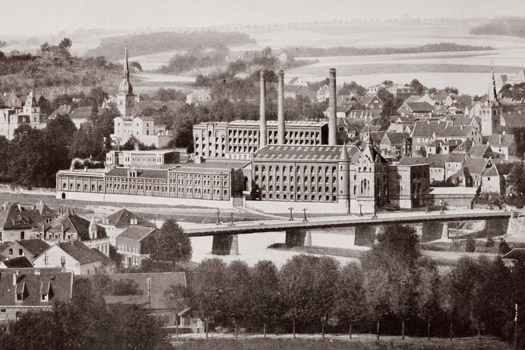
Manufaktur und Tuchfabrik Scheidt
Johann Wilhelm Scheidt kaufte 1797 eine kopierte englische Vorspinnmaschine und läutete damit in Kettwig (heute zu Essen) das Industriezeitalter ein.
© Stiftung Rheinisch-Westfälisches Wirtschaftsarchiv zu Köln
Kapital zurück zur Auswahl
Scheidt textile manufacturer and factory: English spinning machine for Kettwig
On Kirchfeld Street in Kettwig – today a residential area – industrialization of the town loomed overhead in 1799 with a technical sensation: in the year before, Johann Wilhelm Scheidt entered the family business, which was founded in 1720. He bought a spinning machine, on which just one worker could spin one or many dozen roving threads faster and more evenly than was ever possible with the spinning wheel.
The machine was similar to the English “Spinning Jenny“ for which Scheidt paid 60 thalers – the yearly income of one of his spinners. He did not acquire the machine directly from England, but bought it from his business colleague Gottfried Wilhelm Brügelmann, who had operated a factory near Ratingen using the English model since 1784; today this factory belongs to the LWL Industrial Museum. The technical Know-how and machine parts for this factory mostly came from England. Brügelmann, the cotton manufacturer, further developed the machines and sold them to Scheidt, among others, who himself worked with wool so was not a competitor.
Scheidt's manufacturing area behind the classical family villa (which still exists today) was not yet a real factory in 1799 as there was no central source of power for operating the machines, like a water wheel or a steam engine. His attempts with horsepower failed, and the machines continued to be operated by hand so the company continued as a decentralized manufacturing operation. Scheidt most likely re-equipped the new machine to work with wool and then constructed others based on that model. From then on wool could be centrally spun in Kirchfeld. And spinners and weavers could then make ready yarn and textiles from it.
Scheidt’s textile factory finally took hold in 1837 on the banks of the Ruhr in Kettwig. Using steam, and, from 1902, waterpower the entire production of the textiles was conducted in one place with mechanical weaving looms replacing handmade craft. Having been rebuilt and expanded after many fires, in 1914 the factories took up the majority of Kettwig's Ruhr bank. The company also owned a worsted yarn factory, whose extended Scheddach halls originate from 1911. These halls have been partially preserved in the same way as the textile factory, which was renovated for residential purposes. The Scheidt factories were expanded through workhouses and a “home for girls” in 1906. This home was built for single women recruited from East and West Prussia, who formed the majority of the workforce in the factory.
Denkmale zum Impuls
Essen - Tuchfabrik Scheidt und Weberdorf Kettwig
An der Kirchfeldstraße 16 ist eine klassizistische Villa der Familie Scheidt von 1799 ... weiter
Essen - Die Scheidtsche Tuchfabrik an der Ruhr
Wenngleich sich mit dem Erwerb der ersten Vorspinnmaschine schon in den Manufakturgebäuden ... weiter

